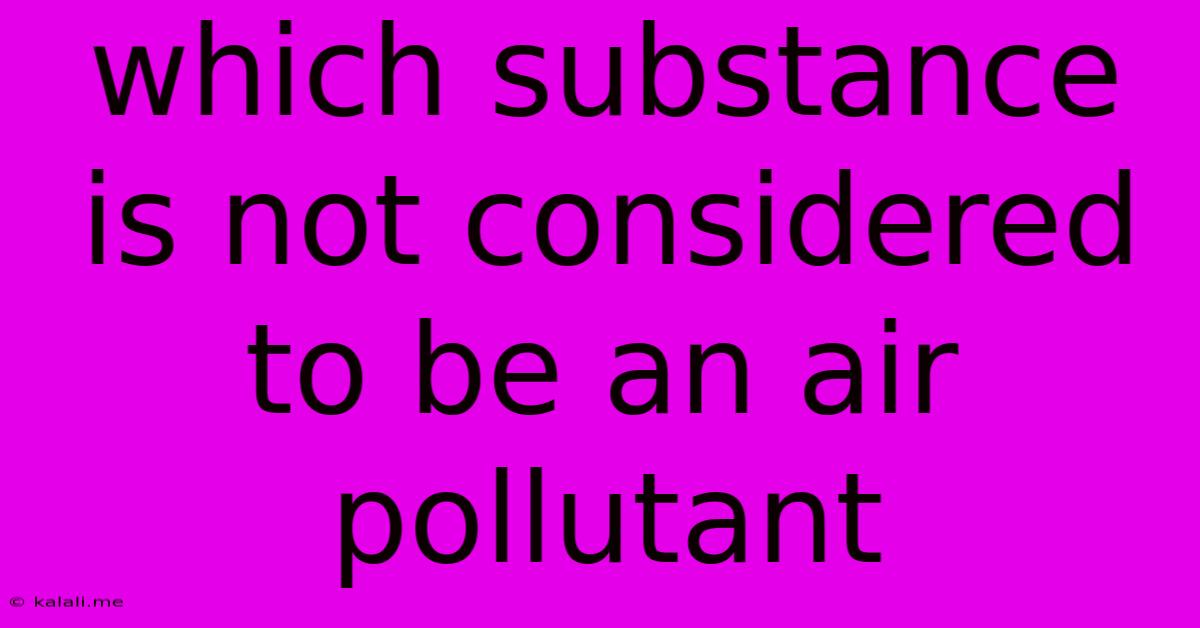Which Substance Is Not Considered To Be An Air Pollutant
Kalali
Jun 14, 2025 · 3 min read

Table of Contents
Which Substance is Not Considered to Be an Air Pollutant?
Air pollution is a significant environmental concern, impacting human health and the planet's ecosystems. Understanding what constitutes an air pollutant is crucial to mitigating its effects. This article will explore the definition of air pollutants and identify a substance generally not considered to be one: water vapor.
While many substances contribute to air pollution, certain naturally occurring components of the atmosphere are generally excluded from this classification. This is because their presence, within typical atmospheric concentrations, doesn't negatively impact human health or the environment in the same way as pollutants do.
Defining Air Pollutants
Air pollutants are substances present in the atmosphere that, at certain concentrations, can harm human health, damage ecosystems, or deteriorate materials. These substances can be gaseous, liquid, or solid. Common examples include:
- Particulate Matter (PM): Tiny particles suspended in the air, such as dust, soot, and smoke. PM2.5 and PM10 are particularly harmful due to their small size, allowing them to penetrate deep into the lungs.
- Nitrogen Oxides (NOx): Gases produced during combustion processes, contributing to smog formation and respiratory problems.
- Sulfur Dioxide (SO2): A gas released from burning fossil fuels, leading to acid rain and respiratory illnesses.
- Ozone (O3): A highly reactive gas that is a major component of smog. While beneficial in the stratosphere, ground-level ozone is harmful to human health and vegetation.
- Volatile Organic Compounds (VOCs): Gases emitted from various sources, including vehicles, industrial processes, and solvents. Many VOCs contribute to smog formation.
- Carbon Monoxide (CO): A colorless, odorless gas produced by incomplete combustion. CO can displace oxygen in the blood, leading to serious health consequences.
Water Vapor: An Exception
Unlike the pollutants listed above, water vapor (H₂O), in its naturally occurring atmospheric concentrations, is generally not considered an air pollutant. Water vapor is an essential component of the Earth's atmosphere, playing a vital role in the water cycle and weather patterns. It's a natural byproduct of evaporation and transpiration, and its presence is crucial for life on Earth.
While excessive amounts of water vapor in localized areas can contribute to fog or other visibility-reducing conditions, it doesn't inherently pose the same risks to human health or the environment as other air pollutants. The key difference lies in its natural abundance and lack of inherent toxicity at typical atmospheric concentrations.
Differentiating between Water Vapor and other Air Pollutants
It's important to distinguish between water vapor and other substances sometimes found in the atmosphere. For instance, water vapor can act as a carrier for other pollutants, such as heavy metals or acidic compounds. In these cases, the pollutants themselves, not the water vapor, are the environmental concerns. Similarly, excessive moisture can contribute to the growth of mold and mildew, which can release harmful compounds. However, the moisture itself isn't the primary pollutant in these scenarios.
Conclusion
In summary, while many substances contribute to air pollution, water vapor in its natural state is generally not considered an air pollutant. Its crucial role in the water cycle and lack of inherent toxicity at normal atmospheric levels differentiate it from the harmful substances that compromise air quality. Understanding this distinction is essential for effective air pollution management and environmental protection strategies.
Latest Posts
Latest Posts
-
What Is The Scientific Name Of The Dog
Jun 14, 2025
-
Consider The Following Data For Chromium
Jun 14, 2025
-
Which Of The Following Represent Isotopes
Jun 14, 2025
-
How Many Brick Are In A Cube
Jun 14, 2025
-
A Centrifugal Switch Is Used In A
Jun 14, 2025
Related Post
Thank you for visiting our website which covers about Which Substance Is Not Considered To Be An Air Pollutant . We hope the information provided has been useful to you. Feel free to contact us if you have any questions or need further assistance. See you next time and don't miss to bookmark.